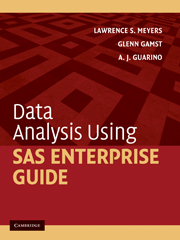Book contents
- Frontmatter
- Contents
- Preface
- Acknowledgments
- I Introducing SAS Enterprise Guide
- II Performing Analyses and Viewing Output
- III Manipulating Data
- IV Describing Data
- V Score Distribution Assumptions
- VI Correlation and Prediction
- 15 Bivariate Correlation: Pearson Product–Moment and Spearman Rho Correlations
- 16 Simple Linear Regression
- 17 Multiple Linear Regression
- 18 Simple Logistic Regression
- 19 Multiple Logistic Regression
- VII Comparing Means: The t Test
- VIII Comparing Means: ANOVA
- IX Nonparametric Procedures
- X Advanced ANOVA Techniques
- XI Analysis of Structure
- References
- Author Index
- Subject Index
18 - Simple Logistic Regression
Published online by Cambridge University Press: 05 June 2012
- Frontmatter
- Contents
- Preface
- Acknowledgments
- I Introducing SAS Enterprise Guide
- II Performing Analyses and Viewing Output
- III Manipulating Data
- IV Describing Data
- V Score Distribution Assumptions
- VI Correlation and Prediction
- 15 Bivariate Correlation: Pearson Product–Moment and Spearman Rho Correlations
- 16 Simple Linear Regression
- 17 Multiple Linear Regression
- 18 Simple Logistic Regression
- 19 Multiple Logistic Regression
- VII Comparing Means: The t Test
- VIII Comparing Means: ANOVA
- IX Nonparametric Procedures
- X Advanced ANOVA Techniques
- XI Analysis of Structure
- References
- Author Index
- Subject Index
Summary
Overview
Logistic regression is conceptually analogous to linear regression in that a single dependent variable is predicted from either a single predictor (simple logistic regression) or multiple predictors (multiple logistic regression) based on a prediction model. It is also permissible to use both quantitatively measured and dichotomously (binary) coded variables as predictors. Our example for this chapter involves a single quantitatively measured predictor variable.
Some differences between linear and logistic regression
Although the two regression methods are conceptually similar, the differences between linear and logistic regression are important. Three of the most salient differences are as follows:
In linear regression, the dependent variable is quantitatively measured; in logistic regression, the dependent variable is categorical. We will limit ourselves to a dichotomously coded dependent variable.
In linear regression, a straight line function is fitted to the data set by using an ordinary least squares method; in logistic regression, a logistic function (an S-shaped function) is fitted to the data set by using a maximum likelihood estimation procedure.
In linear regression the value of the quantitatively measured dependent variable is predicted; in logistic regression the dependent variable is categorical and what is predicted is the likelihood that a case with a certain value or values on the predictor(s) is a member of a particular group (the reference group).
- Type
- Chapter
- Information
- Data Analysis Using SAS Enterprise Guide , pp. 177 - 184Publisher: Cambridge University PressPrint publication year: 2009



